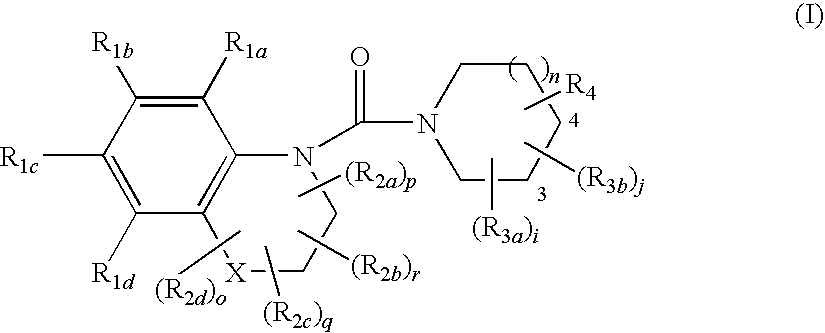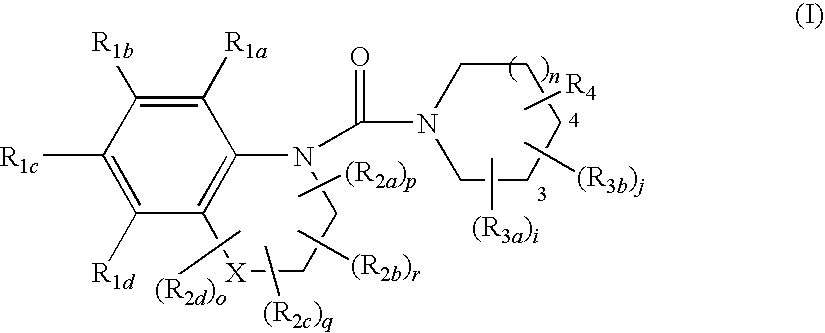Substituted quinoxalines, their preparation and their therapeutical use as 11βHSD1 modulators
a quinoxaline and quinoxaline technology, applied in the direction of drug compositions, immunological disorders, metabolism disorders, etc., can solve the problems of glaucoma induced by the use of corticosteroids, partial loss of vision field, and progression to dementia
- Summary
- Abstract
- Description
- Claims
- Application Information
AI Technical Summary
Benefits of technology
Problems solved by technology
Method used
Image
Examples
example 1
1′-(3,4-Dihydroquinolin-1(2H)-ylcarbonyl)spiro[indene-1,4′-piperidine] (Compound No. 15)
1.1: 4-Nitrophenyl 3,4-dihydroquinoline-1(2H)-carboxylate
[0531]10 g of 1,2,3,4-tetrahydroquinoline, 10.46 ml of triethylamine, 270 ml of tetrahydrofuran and then 15.13 g of para-nitrophenyl chloroformate are introduced into a 1 l round-bottomed flask. The reaction medium is stirred at ambient temperature for two hours and then filtered. The solvent is evaporated under reduced pressure and the residue is taken up in dichloromethane and washed with a 2N aqueous hydrochloric acid solution and then twice with water. The organic phase is dried over magnesium sulfate and the solvent is evaporated under reduced pressure to result in 21.5 g of 4-nitrophenyl 3,4-dihydroquinoline-1(2H)-carboxylate.
[0532]M+H+=299.5
1.2: 1′-(3,4-Dihydroquinolin-1(2H)-ylcarbonyl)spiro[indene-1,4′-piperidine]
[0533]0.4 g of 4-nitrophenyl 3,4-dihydroquinoline-1(2H)-carboxylate, 0.357 g of 4-spiroindene-piperidine hydrochloride, 0...
example 2
1-(3,4-Dihydroquinolin-1(2H)-ylcarbonyl)-4-phenylpiperidine-4-carbonitrile (Compound No. 17)
2.1: 3,4-Dihydroquinoline-1(2H)-carbamic Acid Chloride
[0536]4.9 g of triphosgene are added to a solution of 5.5 g of 1,2,3,4-tetrahydroquinoline and 6.4 ml of triethylamine in 213 ml of dichloromethane at 0° C. The reaction mixture is stirred for 3 h and is then poured onto a mixture of water and ice. A saturated aqueous sodium hydrogencarbonate solution and dichloromethane are added. The aqueous phase is extracted with dichloromethane. The organic phases are combined, washed with water and with a saturated aqueous sodium chloride solution and dried over sodium sulfate and then the solvent is evaporated under reduced pressure to result in 7.8 g of 3,4-dihydroquinoline-1(2H)-carbonyl chloride.
[0537]M+H+=196.4
2.2: N,N-bis(2-Chloroethyl)-3,4-dihydroquinoline-1(2H)-carboxamide
[0538]A solution of 7 g of 3,4-dihydroquinoline-1(2H)-carbamic acid chloride in 180 ml of acetonitrile is introduced into ...
example 3
4-[(3-(Pyridin-3-yl)pyrrolidin-1-yl)carbonyl]-3,4-dihydro-2H-1,4-benzoxazine Hydrochloride (Compound No. 26)
3.1: 4-Nitrophenyl 2,3-dihydro-4H-1,4-benzoxazine-4-carboxylate
[0543]1 g of 3,4-dihydro-2H-1,4-benzoxazine, 1.03 ml of triethylamine, 27 ml of tetrahydrofuran and then 1.5 g of para-nitrophenyl chloroformate are introduced into a 100 ml round-bottomed flask. The reaction mixture is stirred at ambient temperature for three hours and then filtered. The solvent is evaporated under reduced pressure and the residue is taken up in dichloromethane and washed with a 2N aqueous hydrochloric acid solution and then twice with water. The organic phase is dried over magnesium sulfate and the solvent is evaporated under reduced pressure to result in 2.1 g of 4-nitrophenyl 2,3-dihydro-4H-1,4-benzoxazine-4-carboxylate.
[0544]M+H+=301
3.2: 4-[(3-(Pyridin-3-yl)pyrrolidin-1-yl)carbonyl]-3,4-dihydro-2H-1,4-benzoxazine
[0545]0.2 g of 4-nitrophenyl 2,3-dihydro-4H-1,4-benzoxazine-4-carboxylate, 0.1 g o...
PUM
| Property | Measurement | Unit |
|---|---|---|
| temperature | aaaaa | aaaaa |
| temperature | aaaaa | aaaaa |
| temperature | aaaaa | aaaaa |
Abstract
Description
Claims
Application Information
 Login to View More
Login to View More - R&D
- Intellectual Property
- Life Sciences
- Materials
- Tech Scout
- Unparalleled Data Quality
- Higher Quality Content
- 60% Fewer Hallucinations
Browse by: Latest US Patents, China's latest patents, Technical Efficacy Thesaurus, Application Domain, Technology Topic, Popular Technical Reports.
© 2025 PatSnap. All rights reserved.Legal|Privacy policy|Modern Slavery Act Transparency Statement|Sitemap|About US| Contact US: help@patsnap.com



